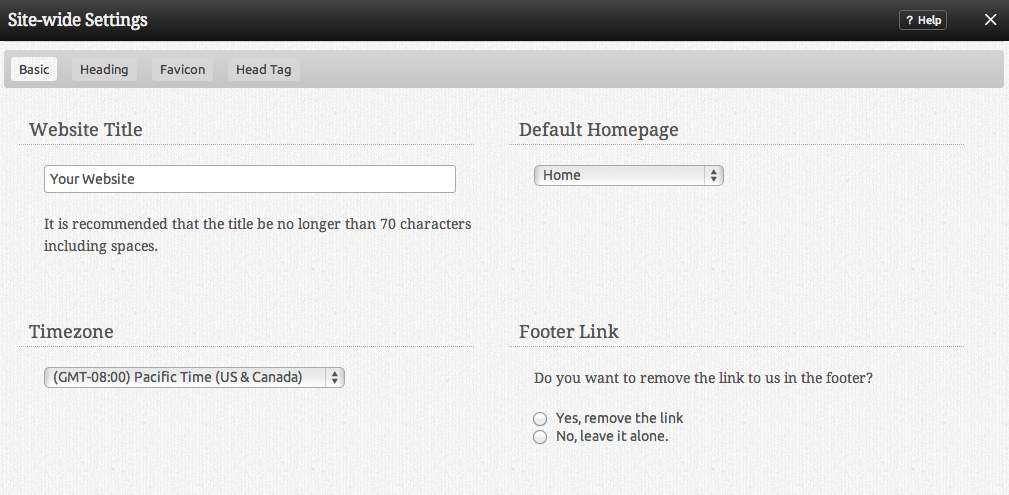Advanced Website Settings: Difference between revisions
No edit summary |
|||
| Line 1: | Line 1: | ||
==Where to Find== | |||
This area can be found under 'Side-wide Settings' in the "Manage Website" section of the [[Toolbar]]. | |||
A '''Favicon''' is the small picture that appears to the left of your websites address in your web browser. You can select from a list of preset icons by clicking on "Select Icon", or upload one of your own ''(file must be a 16x16 pixel .ico file to upload)''. If you don't have an icon editor, you may upload a standard graphic file to a generator, such as [http://www.favicon.cc/ favicon.cc]. | A '''Favicon''' is the small picture that appears to the left of your websites address in your web browser. You can select from a list of preset icons by clicking on "Select Icon", or upload one of your own ''(file must be a 16x16 pixel .ico file to upload)''. If you don't have an icon editor, you may upload a standard graphic file to a generator, such as [http://www.favicon.cc/ favicon.cc]. | ||
The ''' | The '''Head Tag''' area contains the head element. Elements inside '''<head>''' tags can include scripts, instruct the browser where to find stylesheets, provide meta information, and more. This is an extremely useful feature to create site-wide meta information that won't be removed if you change or upload a theme. For example, a description for your site, or keywords search engines can use to better index your site. Of course, keywords and descriptions for a specific page can still be managed in it's [[Page Settings]]. | ||
[[Image:Websitesettings2.PNG]] | |||
==Site-wide SEO== | |||
This area can be found under 'Site-wide SEO Settings' in the "Manage Website" section of the [[Toolbar]]. | |||
'''Robots.txt''' is a file used to give special instructions to web robots. This allows you to block certain web robots from certain parts of your website, or direct them to relevant information. | |||
A '''Sitemap XML''' file lists the URLs for your website that are most important. This allows search engines to crawl the site more intelligently. These are now auto-discoverable by search engines, which will help your site get indexed better and quicker. | |||
Revision as of 12:38, 18 December 2013
Where to Find
This area can be found under 'Side-wide Settings' in the "Manage Website" section of the Toolbar.
A Favicon is the small picture that appears to the left of your websites address in your web browser. You can select from a list of preset icons by clicking on "Select Icon", or upload one of your own (file must be a 16x16 pixel .ico file to upload). If you don't have an icon editor, you may upload a standard graphic file to a generator, such as favicon.cc.
The Head Tag area contains the head element. Elements inside <head> tags can include scripts, instruct the browser where to find stylesheets, provide meta information, and more. This is an extremely useful feature to create site-wide meta information that won't be removed if you change or upload a theme. For example, a description for your site, or keywords search engines can use to better index your site. Of course, keywords and descriptions for a specific page can still be managed in it's Page Settings.
Site-wide SEO
This area can be found under 'Site-wide SEO Settings' in the "Manage Website" section of the Toolbar.
Robots.txt is a file used to give special instructions to web robots. This allows you to block certain web robots from certain parts of your website, or direct them to relevant information.
A Sitemap XML file lists the URLs for your website that are most important. This allows search engines to crawl the site more intelligently. These are now auto-discoverable by search engines, which will help your site get indexed better and quicker.

